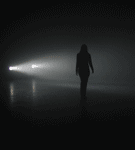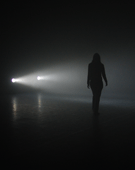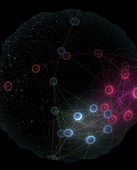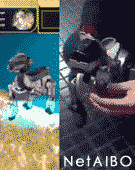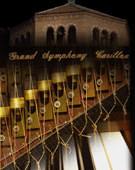The concepts behind this minimalist sculpture are surprisingly complex. The work fits well into some contemporary research in ambient telepresence—the transformation of space as a form of GUI. Ambient telepresence is about awareness, not communication, and points to a trend to make use of the entire physical environment as an interface to remote digital information. Instead of various information sources competing against each other for a relatively small amount of real estate on a screen, information is moved off the monitor and into the physical environment. Working with ambience is an interesting subgenre of telepresence where temperature, sound, lighting, etc. are the interface. Additionally, the sculptural relationship with an environment relates to the 1960’s Land Art movement and “Mulholland Drive” functions as a mediated earthwork.
As we struggle for a clear definition of ‘interactive’, we settle for its characteristics and goals. It is art that senses, responsive work. It is ...
Full Description
The concepts behind this minimalist sculpture are surprisingly complex. The work fits well into some contemporary research in ambient telepresence—the transformation of space as a form of GUI. Ambient telepresence is about awareness, not communication, and points to a trend to make use of the entire physical environment as an interface to remote digital information. Instead of various information sources competing against each other for a relatively small amount of real estate on a screen, information is moved off the monitor and into the physical environment. Working with ambience is an interesting subgenre of telepresence where temperature, sound, lighting, etc. are the interface. Additionally, the sculptural relationship with an environment relates to the 1960’s Land Art movement and “Mulholland Drive” functions as a mediated earthwork.
As we struggle for a clear definition of ‘interactive’, we settle for its characteristics and goals. It is art that senses, responsive work. It is a world unfolding where the subject, the audience, and the characteristics of the piece are all in flux...it is art constructed as a context for experience. In the late 1960’s, a rebel group of sculptors created a movement that produced a body of art that considered this ‘interactivity’ with environment. The Earthworks movement celebrated art as a spatial event--sculpture was viewed as malleable, changing, entropic, and participatory. Earthworks connected physically with their environments and were designed to react to the forces found there. This emphasis on time and process forced viewers to look at the dynamics of the elements in the environment. One had to experience different stages of the system to experience the whole work…which had its own life span.
Finally, the narrative experience of this sculpture leads us to consider the concept of cinema without image…the work is intensely cinematic but uses projection as image, not medium. As artists, we stripped cinema of its screen and its image, attempting to create a cinematic experience with only the component of projection—can a beam of light tell a story? In “Mulholland Drive”, the movement of the lights creates a spatialization of the journey—we experience the drama of the course by hearing the engine speed up on the straight sections and seeing the dramatic light angles reflect the hairpin curves.
In 1968 Earthworks artist Robert Smithson pioneered the sculptural concept of ‘non-sites’. These pieces consisted of materials gathered from several sites, usually rocks or minerals, that he then regrouped in geometric containers and displayed.
"I created a dialectic of site and nonsite. The nonsite exists as a kind of deep three-dimensional abstract map that points to a specific site on the surface of the earth...designated by a kind of mapping procedure" (Smithson).
The nonsite becomes an abstraction, a mapping source, which references the real/actual site from which materials are taken. Instead of rocks, “Mulholland Drive” gathers data and presents it as a non-site. Interestingly, a new form of ‘drawing’ reverses the interactivity with the environment. GPS Drawings are made by traveling along the shapes and squiggles using Global Positioning System (GPS).
“In essence GPS Drawing is about recording lines using ones journey as a mark making medium. The GPS receiver automatically records your journey like a geodesic pencil.” (www.gpsdrawing.com)
We are just beginning to explore topography as a tool for the creation of artwork. Haruki Nishijima’s “Remain in Light " is a light representation of data—here ambient audio is captured and then translated into light and motion. His sensing device is a ‘net’…to capture sound.
“By waving this net while walking, we become aware of not only the condition of the space but also the actual situation of our communications monitored by information.” (www.ima.fa.geidai.ac.jp)
Hiroshi Sugimoto’s time-lapse photographs of the duration of a film reveal a bright, white screen. His work, although in a cinematic environment of classic movie palaces, emphasizes the light of the projection. Sugimoto’s ethereal images are limited by his static medium and in “Mulholland Drive”, we hope to animate the projection and consider the role of nonimage- based cinema with sensed interactivity.
prototype
In a large dark space filled with fog, two robotic lights will recreate the terrain of Mulholland Drive through changes in angle and sound. Audience members will be able to wander through the fog and immerse in the ambience.
On May 12, 2004 at 11:00pm, the artists outfitted a Honda Civic to capture the angle, direction, location, speed, and engine rpm data of a drive along the section of Mulholland Drive between Beverly Glen and Coldwater Canyon. Tilt was captured through a sensor, run through a battery-powered EasyIO board, and saved on a laptop running tilt measurement software. GPS was captured on a portable sensor and downloaded to a computer at a later time. RPM data was sensed via an engine-mounted microphone wired into a laptop running a sound capture software. The rpm data was also captured through a digital video camera directed at the dashboard tachometer. The process and configuration was documented with a digital still camera. The captured data was then loaded into Director and a three-dimensional path was created. Additionally, the artists created an animation of the lights to confirm our direction with the project. The engine recording was converted into a MIDI file and manipulated in several different softwares to discover whether a ‘melody’ was possible—variations in instrumentation, tone, and distortion were explored. In the end, a mix of the original recording (compressed to enhance the rev sound) and a low orchestral conversion was selected. Using Kolo as midware, the DMX interface was configured to control two robotic lights.
On June 5, 2004 the artwork was set up in the gymnasium at UCLA’s Wooden Center. A laptop running Director used a DMX interface to control two 750 Watt Martin MAC600 Moving Head Lights, each powered through a separate transformer to increase the voltage from 110 to 240. Two fog machines, a Rosco 4500 and 1500, generated the smoke. The engine sound and score was run from the laptop into an amplifier that tapped into the stadium sound system built into the gymnasium walls. The installation was documented with two digital still cameras and a Canon XL-1 video camera. The experience was dramatic, ethereal, moving. Audience members commented on the haunting ‘noir’ component of the piece and the strange abstraction of the lights...somehow both static and motionary. One participant even mentioned that the lights felt like ‘eyes’. Overall, we were pleased with the drama and power of the installation.
Although we were aiming for a passive interactivity generated by programmed ambience, we are intrigued by the conceptual framework of “Mulholland Drive” and can project several directions to pursue after this initial prototype. A database of several roads that were previously captured could present the visitor with the option to ‘choose their own journey’. In an impossibly sensed future, we could even show them their own drive home by using archived GPS and altitude data. We’ve also considered the live modification of the ‘score’ as an interactive feature—the user could use a slider to adjust, the amount of processing of the engine rev data, from the ‘true’ sound to an extreme abstraction like orchestration. Finally, the vision of a live capture and presentation of a journey could prove interesting…even moving beyond roads to roller coasters and fighter planes. An audience could watch a sculptural interpretation of a live topographic event.
conclusion
One of cinema’s miraculous tools is the creation of an environment, a window into a world that is designed by its author. But can the process be reversed? Can environment create art? New media technologies are introducing the possibility of environmental agency in sculptural, cinematic, and narrative construction. Space can now become a protagonist, not metaphorically but literally, in the creation of the moving image. Computerization now allows for the direct, real time impact of a space on artworks. New media’s interface with the world around us increases each day and several trends in new media are facilitating this dramatic shift. We have a new emphasis on process—we watch our machines as much as their output—and new media is shortening the gap between creation and presentation in artworks. We have a better understanding of interactivity and are more open to stories that unfold in non-linear form. We are able to use more sophisticated sensor technologies and changes in motion, light, sound, and temperature can now be measured computationally through new media. Finally, we now recognize the aesthetics of database and the possibilities of using sensed data to generate art, sculpture, and cinema are just now being explored. One of the lures of exploring environmental agency is the hidden interactivity of the process…the narrative still allows for interactivity’s liquid, floating work of art, but is not controlled by human interface and can be witnessed passively. It seems it is a new form of cinema and sculpture altogether. Suddenly the mysteries, patterns, and random chance of the environment can speak, tell stories, transform space. By reading our environment through new media technology, we may learn more about our world. Perhaps by listening to stories woven by geography, we will feel those pathways differently. Tomorrow’s auteurs may be dynamic spaces.
Work metadata
- Year Created: 2004
- Submitted to ArtBase: Tuesday May 17th, 2005
- Original Url: http://www.martinbonadeo.com.ar/exhibitu.htm
- Permalink: http://www.martinbonadeo.com.ar/exhibitu.htm
-
Work Credits:
- Martin Bonadeo, creator
Take full advantage of the ArtBase by Becoming a Member
